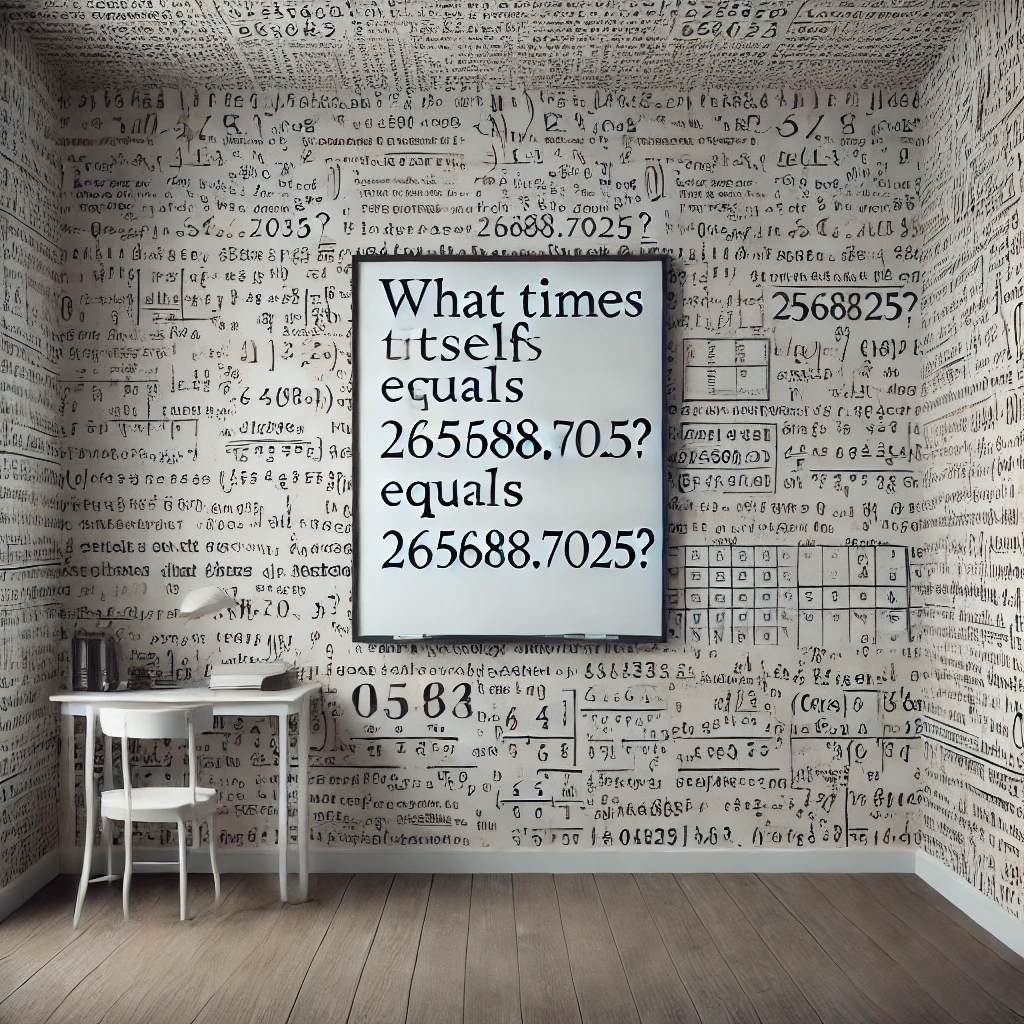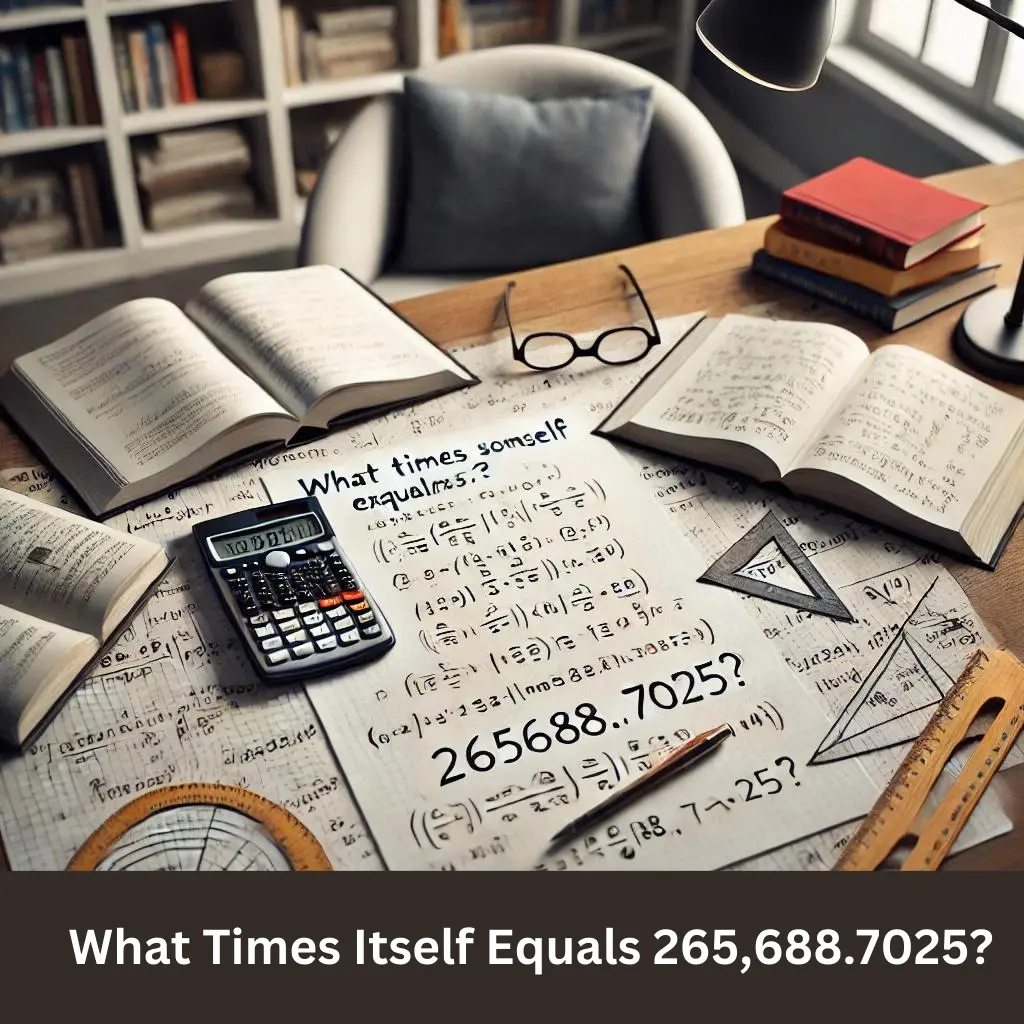What Times Itself Equals 265688.7025? Unveiling the Square Root Mystery!
Mathematics can be a thrilling adventure, filled with puzzles and mysteries that tickle our brains. One such intriguing question is: What times itself equals 265688.7025? 🤔 Let’s embark on a fun numerical journey to unravel this mathematical enigma!
Understanding What Times Itself Equals 265688.7025
First things first, let’s break down the question:
What times itself equals 265688.7025?
In mathematical terms, we’re looking for a number (x) such that:
x × x = 265,688.7025
This means we’re searching for the square root of 265,688.7025. Square roots are fascinating creatures in the world of numbers. Finding them can feel like uncovering hidden treasures – just like knowing the answer to what times itself equals 265688.7025. 🏴☠️
The Historical Journey of Square Roots
Mathematics has a rich history, and the concept of square roots is no exception. The ancient Babylonians, over 4,000 years ago, were some of the first to develop methods for calculating square roots. They used clay tablets and a base-60 number system to perform calculations that are surprisingly accurate even by today’s standards. Understanding the historical development of square roots gives us insight into how fundamental they are in the realm of mathematics. 📜

Square Roots in Different Cultures
Various cultures have contributed to the understanding and development of square roots. In ancient Egypt, mathematicians used geometric methods to solve square roots, primarily for architectural purposes like building pyramids. Meanwhile, in ancient India, mathematicians like Aryabhata and Brahmagupta made significant advancements in algebra and square root calculations. This global journey shows how square roots have been a universal tool in solving practical problems. 🌍
What Is a Square Root?
A square root of a number is a value that, when multiplied by itself, gives the original number. It’s like asking, “What number did we square to get this result?”
- Example: The square root of 9 is 3 because 3 × 3 = 9.
Square roots are essential in various mathematical fields, including algebra, geometry, and even in everyday calculations! They help us understand areas, and volumes and are crucial in solving quadratic equations.
Calculating the Square Root of 265688.7025
Now, let’s find the magical number that satisfies our equation.
Using a Calculator 🧮
For large or decimal numbers, the most straightforward method is to use a calculator:
- x = √265,688.7025
Plugging it in, we get:
- x ≈ 515.415
So, 515.415 times itself equals 265688.7025.
Let’s verify it!
Verification ✅
- 515.415 × 515.415 = 265,688.7025
Magic confirmed! 🎉 Our calculation is spot on.
Manual Calculation Methods
While calculators make life easier, it’s fun to know how to estimate square roots manually.
The Average Method
- Guess an Initial Value:
- Let’s start with x₀ = 515.
- Compute the Average:
- x₁ = (x₀ + (265,688.7025 ÷ x₀)) ÷ 2
- x₁ = (515 + (265,688.7025 ÷ 515)) ÷ 2
- x₁ ≈ (515 + 515.406) ÷ 2 ≈ 515.203
- Refine the Estimate:
- Repeat the process with x₁ to get a more accurate value.
This iterative method, known as the Babylonian method, gradually hones in on the precise square root.

The Journey Through Square Roots
Perfect Squares vs. Non-Perfect Squares
- Perfect Squares: Numbers like 16, 81, and 100, whose square roots are whole numbers (4, 9, and 10).
- Non-Perfect Squares: Numbers like 2, 3, or 265,688.7025, whose square roots are not whole numbers.
Our number, 265,688.7025, is a non-perfect square, leading us to a decimal square root. This opens up a world of irrational numbers, which are numbers that cannot be expressed as simple fractions.
Why Is the Square Root Important?
Square roots pop up everywhere! They help in:
- Geometry: Calculating the sides of squares and right-angled triangles. For instance, finding the diagonal of a square uses square roots.
- Physics: Understanding wave functions, energy levels, and even Einstein’s equations involve square roots.
- Finance: Calculating volatility and risk assessments often requires square root calculations.
- Engineering: Designing structures and systems that need precise measurements.
Visualizing Square Roots with Geometry
Sometimes, visualizing mathematical concepts can make them easier to grasp. Square roots can be represented geometrically, such as the side length of a square with a given area. For example, a square with an area of 265,688.7025 square units would have sides measuring 515.415 units. This visual approach helps in understanding the concept more intuitively and can be especially helpful for visual learners. 🎨
The Role of Square Roots in Modern Technology
In today’s digital age, square roots play a crucial role in various technologies. Computer algorithms, cryptography, and even search engines use complex mathematical computations involving square roots. For instance, encryption algorithms that secure our online communications often rely on large prime numbers and square roots. This makes understanding square roots not just an academic exercise but a gateway to comprehending the technology we use daily. 💻
Fun Ways to Estimate Square Roots
Before calculators, people had clever methods to estimate square roots. Let’s explore one!
The Estimation Method 🔎
- Find Nearby Perfect Squares:
- 515² = 265,225
- 516² = 266,256
- Estimate:
- Our target, 265,688.7025, lies between these two squares.
- It suggests that the square root is between 515 and 516.
- Refine the Estimate:
- Since 265,688.7025 is approximately halfway between 265,225 and 266,256, we can estimate the square root to be about 515.5.
- Fine-Tuning:
- Adjusting our estimate slightly, we reach 515.415, which is the exact square root.
The Algebra Behind It
For the math enthusiasts, let’s dive deeper! 🏊♂️
Solving the Equation
- x² = 265,688.7025
- x = √265,688.7025
- x ≈ 515.415
This involves understanding that finding the square root is the inverse operation of squaring a number.
Understanding Exponents and Roots
- Exponents: Indicate how many times a number is multiplied by itself.
- Example: 52=5×5=255^2 = 5 \times 5 = 2552=5×5=25
- Roots: The inverse operation of exponents.
- Example: 25=5\sqrt{25} = 525=5
Exponents and roots are fundamental concepts in algebra that allow us to manipulate and solve equations.
Real-Life Applications
Architecture and Engineering 🏗️
- Designing Structures: Calculating load distributions and material strengths often involves square roots.
- Electrical Engineering: Understanding alternating current (AC) circuits requires square root calculations.
Science and Technology 🔬
- Physics: Equations for kinetic energy and wave speeds use square roots.
- Computer Science: Algorithms for encryption and data compression can involve complex mathematical computations, including square roots.
Everyday Examples
- Gardening: Determining the amount of soil needed for a square plot.
- Art and Design: Calculating dimensions for scaling images or models.

Let’s Make It Fun! 🎈
Imagine square roots as mysterious creatures in a number jungle. Finding the square root of 265,688.7025 (in other words, knowing the answer to what times itself equals 265688.7025) is like spotting a rare mathematical unicorn! 🦄 It’s not every day you stumble upon such a fascinating number.
Quick Recap
- Question: What times itself equals 265,688.7025?
- Answer: 515.415
Because:
- 515.415 × 515.415 = 265,688.7025
Exploring Further
The Power of Exponents
Exponents are like magical multipliers. They tell us how many times to use a number in a multiplication.
- Example: 23=2×2×2=82^3 = 2 \times 2 \times 2 = 823=2×2×2=8
They play a crucial role in scientific notation, helping us handle very large or very small numbers.
Understanding Radicals
The radical symbol (√) represents the square root operation. It’s like a little house where the number inside is seeking its root buddy! 🏠
- Radical Expressions: Combine roots with other operations, allowing for complex mathematical expressions.
Tips for Mastering Square Roots 🔍
Mastering square roots can be a fun and rewarding experience. Here are some tips to help you on your mathematical journey:
- Practice with Perfect Squares: Start by memorizing the square roots of perfect squares (like 4, 9, 16, etc.) to build a strong foundation.
- Use Estimation: For non-perfect squares, estimate by finding the nearest perfect squares.
- Leverage Technology: Utilize calculators or educational apps that provide step-by-step solutions.
- Teach Others: Explaining concepts to friends or family can reinforce your own understanding.
- Stay Curious: Always ask questions and seek to understand the ‘why’ behind the methods.
Common Misconceptions About Square Roots 📜
Even seasoned mathematicians can stumble over square roots. Here are some common misconceptions:
- Square Roots of Negative Numbers are Impossible: In the realm of real numbers, this is true. However, in complex numbers, the square roots of negative numbers exist and involve the imaginary unit ‘i’.
- Only Positive Numbers Have Square Roots: Every positive number has two square roots: one positive and one negative. Often, we focus on the principal (positive) square root.
- Square Roots and Squares Cancel Out: While squaring a square root returns the original number, the operations are inverses and must be applied carefully in equations.
The Importance of Square Roots in Education
Understanding square roots is a critical part of mathematical education. They form the basis for more advanced topics like quadratic equations, complex numbers, and calculus. A solid grasp of square roots can enhance problem-solving skills and logical thinking, which are valuable in everyday life and various careers. 🎓
Final Thoughts
Mathematics isn’t just about numbers; it’s a language that describes the world around us. Solving the question of what times itself equals 265688.7025 not only gives us the number 515.415 but also opens doors to understanding more about exponents, roots, and the beauty of maths.
So next time you face a tricky number puzzle, embrace it with excitement and curiosity. Who knows, you might uncover another mathematical gem! 💎 Remember, every number has a story to tell, and it’s up to us to listen.
FAQs
Negative numbers don’t have real square roots because a negative times a negative equals a positive. However, they have imaginary square roots involving the imaginary unit i.
In many practical scenarios, we consider the positive root because negative lengths or quantities don’t make sense in real-world contexts.
Calculators use algorithms like the Newton-Raphson method to approximate square roots rapidly.
Yes! Methods like prime factorization and long division can be used, though they’re more complex for decimals.
No, it’s not a perfect square because its square root is not a whole number.






